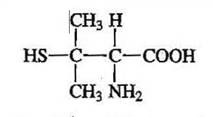Penicillamine Tablets
Dosage form: tablet
Drug class:Antirheumatics
Medically reviewed by Drugs.com. Last updated on Mar 1, 2021.
On This Page
Physicians planning to use penicillamine should thoroughly familiarize themselves with its toxicity, special dosage considerations, and therapeutic benefits. Penicillamine should never be used casually. Each patient should remain constantly under the close supervision of the physician. Patients should be warned to report promptly any symptoms suggesting toxicity.
Penicillamine Tablets Description
Penicillamine is 3-mercapto-D-valine, a disease modifying antirheumatic drug. It is a white or practically white, crystalline powder, freely soluble in water; slightly soluble in alcohol, insoluble in chloroform, ether, acetone, benzene and carbon tetrachloride. Although its configuration is D, it is levorotatory as usually measured:

The empirical formula isC5H11NO2S, giving it a molecular weight of 149.21. The structural formula is:

It reacts readily with formaldehyde or acetone to form a thiazolidine-carboxylic acid.
Penicillamine Tablets, USP (Titratable Tablets) for oral administration contain 250 mg of penicillamine.
Other ingredients (inactive): anhydrous lactose, corn starch, edetate disodium, hypromellose, magnesium stearate, polyethylene glycol and povidone.
Penicillamine Tablets - Clinical Pharmacology
Penicillamine is a chelating agent recommended for the removal of excess copper in patients with Wilson's disease. From in vitro studies which indicate that one atom of copper combines with two molecules of penicillamine, it would appear that one gram of penicillamine should be followed by the excretion of about 200 milligrams of copper; however, the actual amount excreted is about one percent of this.
Penicillamine also reduces excess cystine excretion in cystinuria. This is done, at least in part, by disulfide interchange between penicillamine and cystine, resulting in formation of penicillamin...



